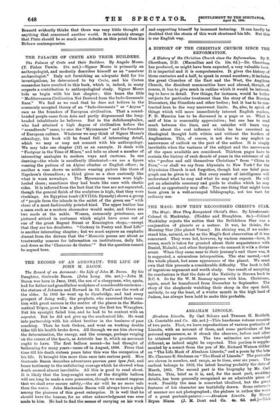THE PALACES OF CRETE AND THEIR BUILDERS.
The Palaces of Crete and their Builders. By Angelo Mosso. (T. Fisher Unwin. 21s. net.)—Signor Mosso is primarily an anthropologist, and modestly describes himself as an "amateur archaeologist." Italy not furnishing an adequate field for his investigations, he determined to try Crete, and his Cretan researches have resulted in this book, which is, indeed, in many respects a contribution to anthropological study. Signor Mosso bids us begin with his last chapter ; this bears the title " Mediterranean Civilization Not Derived from the Indo-Germanic Race." We find as we read that he does not believe in the commonly accepted theory of an Indo-Germanic" or " Aryan " race as the founders of European civilisation. That a round- headed people came from Asia and partly dispossessed the long- headed inhabitants he believes. But in the doliohocephalics, who had attained a high degree of civilisation before the " roundheads " came, be sees the " Mycenaeans " and the founders of European culture. Whatever we may think of Signor Mosses ethnology, his book will be found full of interesting detail, which we may or may not connect with his anthropology. We may take one chapter (12) as an example. It deals with "Footgear in the Time of Minos," and tells us about a number of interesting analogies to modern ways and customs. In one drawing—the whole is excellently illustrated—we see a figure wearing the puttees of an Alpine climber or English officer; in another a vase shows us soldiers wearing gaiters like those of Napoleon's Grenadiers; a third gives us a shoe curiously like what is worn nowadays. The Mycenaean women wore high- heeled shoes ; sometimes they had boots like ours with elastic sides. It is inferred from the fact that the toes are not separated, though the general finish of the sculpture is high, that they wore stockings. An Egyptian tomb (XVIIIth Dynasty) shows a group of "people from the islands in the midst of the green sea" with shoes of a most fashionably pointed kind. The upper leather has a seam such as a modern shoemaker would make, and there are two cords at the ankle. Women, commonly priestesses, are pictured attired in costumes which might have come out of one of the great Regent Street or Kensington shops,—except that they are too decollebies. "Cookery in Poetry and Real Life" is another interesting chapter ; but we must express an emphatic dissent from the dictum that the "Homeric poems are about as trustworthy sources for information on institutions, daily life, and dress as the Chansons de Gestes.' " But the question cannot be argued here.






















































 Previous page
Previous page